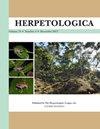Trade-Offs and Vulnerability of Northern Pine Snakes (Pituophis m. melanoleucus): A Comparison of Nest-Site Selection in the Early 1980s and 2020
IF 1.1
3区 生物学
Q2 ZOOLOGY
引用次数: 0
Abstract
Abstract Female reptiles may be able to increase the fitness of offspring by selecting nest sites that are less vulnerable to human disturbances and predators, while providing an appropriate thermal and hydric environment for incubation of their eggs. Northern Pine Snakes (Pituophis melanoleucus) in the New Jersey Pinelands are the only snake in North America known to spend days digging their nests, exposing themselves to predators and people. Both nest site and the habitat selected are critical to ensuring reproductive success. Our overall objective was to determine the factors involved in nest-site selection by Northern Pine Snakes to determine trade-offs females face, and to determine whether these characteristics appear to have changed over the last 37 yr in response to human activities and habitat degradation. We compared characteristics of nest sites, random points within clearings, and random points in the surrounding forest for 42 Northern Pine Snake nests in 2020, and secondly, compared specific characteristics with those of 22 nests examined in 1983. The data indicate that (1) nest sites in 2020 were usually in soft sand, rather than in hard packed sand or in “sugar sand”; (2) sand penetration (e.g., sand density) of nests exhibited a narrow range, while random points were in sand ranging from sugar sand to hard packed sand; (3) the ground cover of nest sites was more often moss/lichen compared with other vegetation; and (4) nest sites were in more open habitats than random points within clearings or the surrounding forest. Compared to the 1980s, Northern Pine Snake nests examined in 2020 were in similar habitat conditions (intermediate sand type, open habitats, with surrounding forests), but were more often on paleodunes, deeper in forests, with higher rates of off-road-vehicle (ORV) disturbances. Females spend 2–4 d digging their nests, presumably to ensure appropriate conditions for offspring embryogenesis and to protect eggs and hatchlings. Our results indicate that, while digging, they are vulnerable to thermal stress, predation, poaching, and mortality from ORVs. Thus our results highlight the trade-off between the fitness of the nesting female and the fitness of her offspring.北方松蛇(Pituophis m.melanoleucus)的权衡与脆弱性:20世纪80年代初和2020年巢址选择的比较
摘要雌性爬行动物可能能够通过选择不太容易受到人类干扰和捕食者影响的巢穴位置来增加后代的健康状况,同时为孵化卵子提供适当的热和水环境。新泽西州松林中的北方松蛇(Pituophis melanoleucus)是北美已知的唯一一种花数天时间挖掘巢穴,将自己暴露在捕食者和人类面前的蛇。巢址和栖息地的选择对确保繁殖成功至关重要。我们的总体目标是确定北方松蛇选择巢穴的因素,以确定雌性面临的权衡,并确定这些特征在过去37年中是否因人类活动和栖息地退化而发生了变化。我们比较了2020年42个北方松蛇巢穴的巢穴位置、空地内的随机点和周围森林中的随机点的特征,其次,将特定特征与1983年检查的22个巢穴的特征进行了比较。数据表明:(1)2020年的巢穴通常在软沙中,而不是在硬沙或“糖沙”中;(2) 巢穴的沙子渗透(如沙子密度)范围很窄,而沙子中的随机点从糖沙到硬填充沙不等;(3) 与其他植被相比,巢址的地面覆盖物更多地是苔藓/地衣;(4)与空地或周围森林中的随机点相比,巢址位于更开阔的栖息地。与20世纪80年代相比,2020年检查的北方松蛇巢穴的栖息地条件相似(中等沙型,开放栖息地,周围有森林),但更多地位于古沙丘上,森林深处,越野车辆(ORV)干扰率更高。雌性花2-4天的时间挖巢穴,大概是为了确保后代胚胎发生的适当条件,并保护卵子和幼崽。我们的研究结果表明,在挖掘过程中,它们很容易受到热应力、捕食、偷猎和ORV造成的死亡的影响。因此,我们的研究结果强调了筑巢雌性的健康状况和其后代的健康状况之间的权衡。
本文章由计算机程序翻译,如有差异,请以英文原文为准。
求助全文
约1分钟内获得全文
求助全文
来源期刊

Herpetologica
生物-动物学
CiteScore
4.60
自引率
0.00%
发文量
27
审稿时长
>12 weeks
期刊介绍:
Established in 1936, Herpetologica is a quarterly peer-reviewed journal serving herpetologists, biologists, ecologists, conservationists, researchers and the scientific community. The journal contains original research papers and essays about the biology of reptiles and amphibians, and covers many relevant topics including: behavior, conservation, ecology, genetics, morphology, physiology and taxonomy.
 求助内容:
求助内容: 应助结果提醒方式:
应助结果提醒方式:


